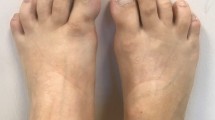Abstract
Background
As invasive medical procedures can induce permanent heterotopic ossification in fibrodysplasia ossificans progressiva (FOP), caution should be exercised in clinical practice. The present study was conducted to examine the characteristics of the great toe deformity in patients with FOP, which may lead to an early diagnosis of this condition.
Methods
The subjects consisted of 31 feet from 16 FOP patients (8 males, 8 females) with an average age of 17.3 years (range 1–47 years) at the time of this study. Gross and radiographic findings, including the hallux valgus angles (HVA), intermetatarsal angles (IMA), and the deformity of the proximal phalanx and metatarsal bone, were examined.
Results
Of the 31 feet, 29 (93.5%) showed several degrees of great toe deformity. A shortened great toe was the typical gross finding and was observed in 20 feet (64.5%). The mean HVA and IMA were 19.7° and 8.5°, respectively; and 22 (71.0%) feet satisfied the radiographic definition of hallux valgus (HVA ≥ 20° or IMA ≥ 10°). The proximal phalanx was consistently shortened but morphologically dissimilar from case to case. The metatarsal bone was also shortened and sharpened to the medial side, deviating the proximal phalanx laterally from the metatarsal axis. Fusion between the distal and proximal phalanx occurred with advancing age. Only two feet in one patient showed no obvious deformity of the great toe.
Conclusions
A shortened great toe and hallux valgus were frequently found in patients with FOP. Shortening and sharpening of the proximal phalanx and metatarsal bone consistently existed and contributed to the great toe deformity. These findings were thought to exist from birth and may be a key to an early diagnosis.
Similar content being viewed by others
References
Delatycki M, Rogers JG. The genetics of fibrodysplasia ossificans progressiva. Clin Orthop 1998;346:15–18.
Connor JM, Evans DA. Fibrodysplasia ossificans progressiva: the clinical features and natural history of 34 patients. J Bone Joint Surg Br 1982;64:76–83.
Rogers JG, Geho WB. Fibrodysplasia ossificans progressiva: a survey of forty-two cases. J Bone Joint Surg Am 1979;61:909–914.
Cohen RB, Hahn GV, Tabas JA, Peeper J, Levitz CL, Sando A, et al. The natural history of heterotopic ossification in patients who have fibrodysplasia ossificans progressiva: a study of fortyfour patients. J Bone Joint Surg Am 1993;75:215–219.
Smith R, Athanasou NA, Vipond SE. Fibrodysplasia (myositis) ossificans progressiva: clinicopathological features and natural history. Q J Med 1996;89:445–446.
Smith R. Fibrodysplasia (myositis) ossificans progressiva: clinical lessons from a rare disease. Clin Orthop 1998;346:7–14.
Vashisht R, Prosser D. Anesthesia in a child with fibrodysplasia ossificans progressiva. Paediatr Anaesth 2006;16:684–688.
Shore EM, Xu M, Feldman GJ, Fenstermacher DA, Cho TJ, Choi IH, et al. A recurrent mutation in the BMP type I receptor ACVR1 causes inherited and sporadic fibrodysplasia ossificans progressiva. Nat Genet 2006;38:525–527.
Nakajima M, Haga N, Takikawa K, Manabe N, Nishimura G, Ikegawa S. The ACVR1 617G > A mutation is also recurrent in three Japanese patients with fibrodysplasia ossificans progressiva. J Hum Genet 2007;52:473–475.
Fukuda T, Kohda M, Kanomata K, Nojima J, Nakamura A, Kamizono J, et al. Constitutively activated ALK2 and increased SMAD1/5 cooperatively induce bone morphogenetic protein signaling in fibrodysplasia ossificans progressiva. J Biol Chem 2009;284:7149–7156.
Glaser DL, Rocke DM, Kaplan FS. Catastrophic falls in patients who have fibrodysplasia ossificans progressiva. Clin Orthop 1998;346:110–116.
Kitterman JA, Kantanie S, Rocke DM, Kaplan FS. Iatrogenic harm caused by diagnostic errors in fibrodysplasia ossificans progressiva. Pediatrics 2005;116:654–661.
Kaplan FS, Xu M, Glaser DL, Collins F, Connor M, Kitterman J, et al. Early diagnosis of fibrodysplasia ossificans progressiva. Pediatrics 2008;121:1295–1300.
Kaplan FS, Le Merrer M, Glaser DL, Pignolo RJ, Goldsby RE, Kitterman JA, et al. Fibrodysplasia ossificans progressiva. Best Pract Res Clin Rheumatol 2008;22:191–205.
Harrison RJ, Pitcher JD, Mizel MS, Temple HT, Scully SP. The radiographic morphology of foot deformities in patients with fibrodysplasia ossificans progressiva. Foot Ankle Int 2005;26:937–941.
Coughlin MJ, Jones CP. Hallux valgus: demographics, etiology, and radiographic assessment. Foot Ankle Int 2007;28:759–777.
Furuya H, Ikezoe K, Wang L, Ohyagi Y, Motomura K, Fujii N, et al. A unique case of fibrodysplasia ossificans progressiva with an ACVR1 mutation, G356D, other than the common mutation (R206H). Am J Med Genet A 2008;146A:459–463.
Author information
Authors and Affiliations
About this article
Cite this article
Nakashima, Y., Haga, N., Kitoh, H. et al. Deformity of the great toe in fibrodysplasia ossificans progressiva. J Orthop Sci 15, 804–809 (2010). https://doi.org/10.1007/s00776-010-1542-5
Received:
Accepted:
Published:
Issue Date:
DOI: https://doi.org/10.1007/s00776-010-1542-5




